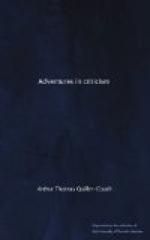How many artists have been twisted from their natural bent by the long vogue of “naturalism” we shall never know. We must make the best of the great works which have been produced under its influence, and be content with that. But we may say with some confidence that Bjoernson’s genius was unfortunate in the date of its maturity. He was born on the 8th of December, 1832, in a lonely farmhouse among the mountains, at the head of the long valley called Osterdalen; his father being priest of Kvikne parish, one of the most savage in all Norway. After six years the family removed to Naesset, in the Romsdal, “a spot as enchanting and as genial as Kvikne is the reverse.” Mr. Gosse, who prefaces Mr. Heinemann’s new series with a study of Bjoernson’s writings, quotes a curious passage in which Bjoernson records the impression of physical beauty made upon his childish mind by the physical beauty of Naesset:—
“Here in the parsonage of Naesset—one of the loveliest places in Norway, where the land lies broadly spreading where two fjords meet, with the green braeside above it, with waterfalls and farmhouses on the opposite shore, with billowy meadows and cattle away towards the foot of the valley, and, far overhead, along the line of the fjord, mountains shooting promontory after promontory out into the lake, a big farmhouse at the extremity of each—here in the parsonage of Naesset, where I would stand at the close of the day and gaze at the sunlight playing over mountain and fjord, until I wept, as though I had done something wrong; and where I, descending on my snow-shoes into some valley, would pause as though bewitched by a loveliness, by a longing, which I had not the power to explain, but which was so great that above the highest ecstasy of joy I would feel the deepest apprehension and distress—here in the parsonage of Naesset were awakened my earliest sensations.”
The passage is obviously important. And Bjoernson shows how much importance he attaches to the experience by introducing it, or something like it, time after time into his stories. Readers of In God’s Way—the latest of the novels under discussion—will remember its opening chapter well.
It was good fortune indeed that a boy of such gifts should pass his early boyhood in such surroundings. Nor did the luck end here. While the young Bjoernson accumulated these impressions, the peasant-romance, or idyll of country life, was taking its place and growing into favor as one of the most beautiful forms of modern prose-fiction. Immermann wrote Der Oberhof in 1839. Weill and Auerbach took up the running in 1841 and 1843. George Sand followed, and Fritz Reuter. Bjoernson began to write in 1856. Synnoeve Solbakken and Arne came in on the high flood of this movement. “These two stories,” writes Mr. Gosse, “seem to me to be almost perfect; they have an enchanting lyrical quality, without bitterness or passion, which I look for elsewhere in vain in the prose literature of the second half of the century.” To my mind, without any doubt, they and A Happy Boy are the best work Bjoernson has ever done in fiction, or is ever likely to do. For they are simple, direct, congruous; all of one piece as a flower is of a piece with its root. And never since has Bjoernson written a tale altogether of one piece.




